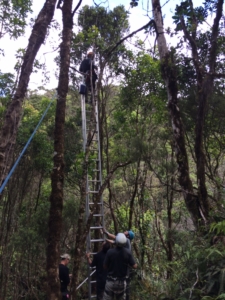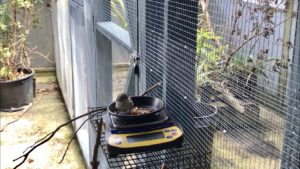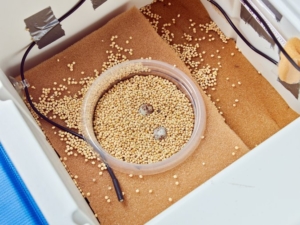Conservation Breeding
Although most of our time is spent on basic and applied research, we have over the last 15 years been involved in two high profile conservation breeding and release programs. From 2015-2018, we were key players in the foundation of conservation breeding populations of ʻakikiki and ʻakekeʻe, following the realization that their extinction was likely imminent given the population trends documented in the 2012 surveys (Paxton et al. 2016). Prior to that, we supported an effort to bolster the wild puaiohi population through the release of captive bred puaiohi. Currently, given the results of the ʻakekeʻe conservation breeding program (see below), we are in the midst of investigating whether translocation to a higher elevation island is warranted for ʻakekeʻe (HCC presentation on habitat modeling for endangered Honeycreepers).
Founding of Conservation Breeding Programs for ʻakikiki and ʻakekeʻe
In 2013, after the 2012 survey data had been analyzed, we realized that both ʻakikiki and ʻakekeʻe were in grave danger. ʻAkikiki had been declining at 71% for many years, and ‘akekeʻe was in free fall with a 91% population decline over the previous decade. A group of experts met and determined that initiation of conservation breeding programs was the best response given current knowledge of these species, available technology, and social and economic considerations. The plan was to collect eggs of both species (removing eggs is considered to have a lower impact on the population because adult honeycreepers, like chickens, usually relay if their eggs disappear), with a goal of having 60 founding individuals of each species to ensure genetic diversity.
 The problem was finding and accessing nests. Both ʻakikiki and ʻakekeʻe nest in tall ʻōhia (Metrosideros polymorpha) trees (4 – 12.5 m above ground) on terminal branches. The height and camflouage of the nests makes them incredibly difficult to find: more than 30 person-hours per nest for ʻakikiki and more than 60 person hours per nest for ʻakekeʻe, which are not territorial so are harder to follow to their nest. Furthermore, the spindly terminal branches would not support the weight of tree climbers. Thus we used a 100-lb, 40-foot ladder to access the nest, no easy feat in a dense rain forest! The top of the ladder was positioned 1-2ft away from and directly under the nest by a team of 5-6 people, and secured by ropes to trees to provide a safe climbing structure. San Diego Zoo Global staff climbed the ladder to collect eggs, as they are skilled in egg handling. They cradled the eggs in a warm soft bed of millet, put them in a small thermos, and lowered them to the ground, where they transferred them to a larger battery powered incubator before the 1-2 hour hike and helicopter flight out of the field. Eggs were incubated and fledged on Kauaʻi, then transferred to SDZG’s permanent facilities on Maui and Hawai’i islands.
The problem was finding and accessing nests. Both ʻakikiki and ʻakekeʻe nest in tall ʻōhia (Metrosideros polymorpha) trees (4 – 12.5 m above ground) on terminal branches. The height and camflouage of the nests makes them incredibly difficult to find: more than 30 person-hours per nest for ʻakikiki and more than 60 person hours per nest for ʻakekeʻe, which are not territorial so are harder to follow to their nest. Furthermore, the spindly terminal branches would not support the weight of tree climbers. Thus we used a 100-lb, 40-foot ladder to access the nest, no easy feat in a dense rain forest! The top of the ladder was positioned 1-2ft away from and directly under the nest by a team of 5-6 people, and secured by ropes to trees to provide a safe climbing structure. San Diego Zoo Global staff climbed the ladder to collect eggs, as they are skilled in egg handling. They cradled the eggs in a warm soft bed of millet, put them in a small thermos, and lowered them to the ground, where they transferred them to a larger battery powered incubator before the 1-2 hour hike and helicopter flight out of the field. Eggs were incubated and fledged on Kauaʻi, then transferred to SDZG’s permanent facilities on Maui and Hawai’i islands.
As of May 2019, there are 44 ʻakikiki and 10 ʻakekeʻe in SDZG’s breeding facilities. Two of the ʻakikiki were born in captivity. The program is considered a success for ʻakikiki and it is hoped that the offspring of these birds will one day be released on Kauaʻi once threats have been abated here. However, the ‘akeke’e population is too small to act as an effective insurance policy for this species, and thus we are considering other options, such as translocation to suitable habitat on Maui or Hawaiʻi islands.
After working tirelessly to prevent the extinction of the rarest forest bird on Kaua’i, the “Saving ‘akikiki from Extinction” team received the 2018 Recovery Champion Award for Region 1.
Release of Captive Bred puaiohi
In the 1990’s, the puaiohi was thought to be on the brink of extinction, so conservation biologists from the USGS and San Diego Zoo Global started a captive breeding program to act as an insurance policy and potentially add birds to the wild population.
A handful of eggs were collected, incubated, and raised to initiate a small conservation breeding population that bred very well in captivity. By 2012—the 14th year of releases—222 of their offspring been released in the forests of the Alakaʻi. After the birds were released, KFBRP staff used radio-tracking and resighting of uniquely color-banded birds to monitor their survival and movements across the forest. Initially, survival was considered very good for a project of this type, and we even confirmed breeding by several birds (Switzer et al. 2013). However, in later years, we found that most of these birds do not survive >1 year post-release (VanderWerf et al., 2014); given this finding, and inbreeding issues in the captive flock, this program was halted, and the remaining puaiohi were released into the Alakaʻi in spring 2016 and 2017.




